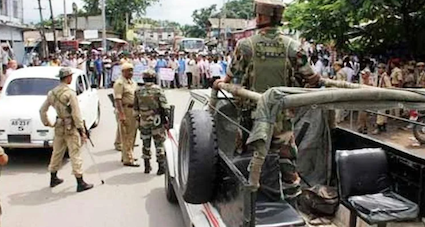In 45 days, after the Centre-appointed panel submits its report, we would know if the Armed Forces Special Powers Act (AFSPA) remains or goes out of Nagaland.
It’s an Act which provides legal immunity to armed forces for their actions in disturbed areas. A civilian court could only begin prosecution after the central government gives its sanction.
This process in itself is a globally accepted norm. Army is trained for war, not in civil laws. Therefore in civilian situations, they got to be given legal protection. No army in the world ever gets deployed in a civil situation without legal protection.
It’s now a common knowledge that AFSPA has been withdrawn from large parts of the NorthEast: Tripura, Meghalaya, districts of Arunachal Pradesh and Assam. But Nagaland has remained an exception because of its insurgency which is as old as independent India. Indeed the entire state was once again brought under AFSPA only last year due to its “disturbed” status.
However, after the botched army operation in Mon district on December 4, which cost six civilian lives, the clamour has grown in the little State for abolition of AFSPA. Its assembly has passed a unanimous resolution for repealing the Act.
xxx
A little background of troubles in Nagaland is in order to understand the Centre’s concern over the years, irrespective of different governments.
Insurgency in Nagaland has claimed hundreds of lives. The insurgents have bases across the international border in Myanmar. Army operates in a war-like situation against well-armed and trained guerrilla outfits in hostile terrain.
In its origin, the AFSPA has its inspiration from a British era ordinance which was promulgated to crush the Quit India movement in 1942.
After independence, India too passed four ordinances in 1947 to deal with the internal security situation that arose because of partition of India. They concerned Bengal, Assam, East Bengal and the United Provinces.
These ordinances later became Acts but were repealed in 1957. However, just a year later, in 1958, the growing Naga insurgency forced the Centre to bring it back as the Armed Forces Assam and Manipur Special Powers Act, 1958.
(It’s only in fitness of things that we pause here and recall that most NorthEastern states were earlier part of Assam. They began separating into independent States in 1970. In 1963, the Naga Hills turned into Nagaland. In 1972, Meghalaya was carved out of Assam. In 1972, Arunachal Pradesh and Mizoram were separated from Assam, first becoming union territories and later States in 1986.)
In due course, the scope of the Act was extended to all the seven NorthEastern states. (Later, in 1983, it was extended to Punjab at the height of Khalistan movement; and in 1992 to Jammu and Kashmir after the exodus of Kashmiri Pandits).
The genesis of it could be traced to 1952 when the Naga National Council called for a total boycott of the first elections in India. No Nagaland citizen filed nomination or cast vote in the elections which were held simultaneously for Lok Sabha and state assembly. The boycott were later extended to government schools and officials.
The government of Assam, in order to curb the raging insurgency, imposed the Assam Maintenance of Public Order Act in the Naga Hills in 1953.
Assam thereafter deployed the Assam Rifles in the Naga Hills and activated the Assam Disturbed Areas Act, 1955, thereby providing a legal framework for the paramilitary forces and its state police.
However, the situation only worsened.On March 23, 1956, the rebel Naga Nationalist Council formed a parallel government.
On May 22, 1958, the Armed Forces Assam and Manipur Special Powers of Armed Forces Ordinance, 1958 were promulgated by the then-president Dr Rajendra Prasad. On September 11, 1958, it was replaced by the Armed Forces Assam and Manipur Special Powers Act.
In 1964, the United National Liberation Front (UNLF) raised the demand for money for secession from India. Two years later, Mizo National Front also launched a revolt. The Assam government declared the entire Mizo district as a disturbed area and enforced the earlier avtaar of AFSPA.
In 1971, the Centre passed the North-Eastern Areas (Reorganization) Act to provide for the establishment of the states of Manipur and Tripura formation of the state of Meghalaya and the union territories of Mizoram and Arunachal Pradesh.
This led to an amendment in AFSPA in 1972. In 1986 Mizoram and Arunachal Pradesh were granted the status of states after which AFSPA was implemented in these states, too.
xxx
The panel’s recommendation is critical not just for Nagaland but for the entire security and unity of India. NorthEast is a part of India where influx of illegal immigrants from Bangladesh abounds. It’s a region which is eyed both by Islamist forces and a bitter rival China looking to foment trouble in India. India faces multiple security issues in Punjab, Jammu and Kashmir and Bengal as it were. The diluted role of army in NorthEast could really singe. But then when have our politicians bothered about the nation, hostage as they are to their own whims and possibly to the inimical forces of India?


